实验3:OpenFlow协议分析实践
实验3:OpenFlow协议分析实践
一、拓扑文件

二、wireshark抓包分析
(1)OFPT_HELLO
控制器6633端口(最高支持OpenFlow 1.0) ---> 交换机58074端口
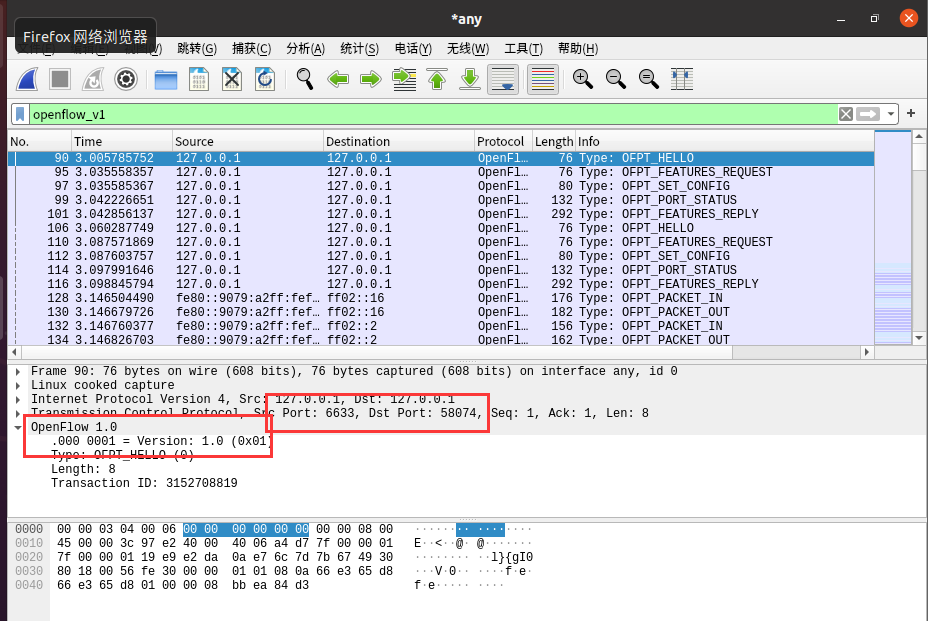
交换机58074端口(最高支持OpenFlow 1.3)--->控制器6633端口
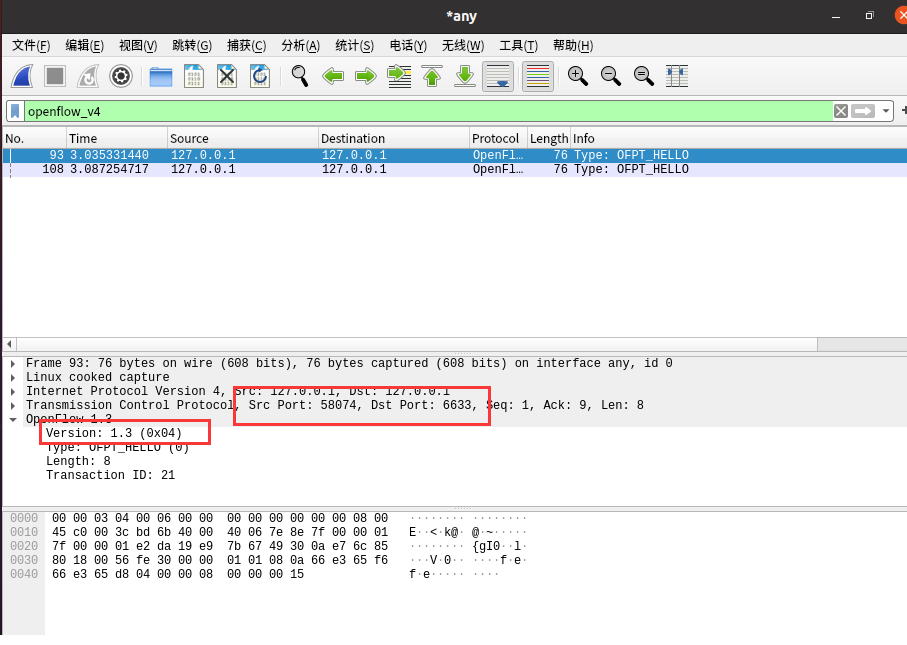
(2)OFPT_Features_Request
控制器6633端口(我需要你的特征信息) ---> 交换机58074端口

(3)OFPT_Set_Config
控制器6633端口(请按照我给你的flag和max bytes of packet进行配置) ---> 交换机58076端口

(4)Port_Status
当交换机端口发生变化时,告知控制器相应的端口状态。
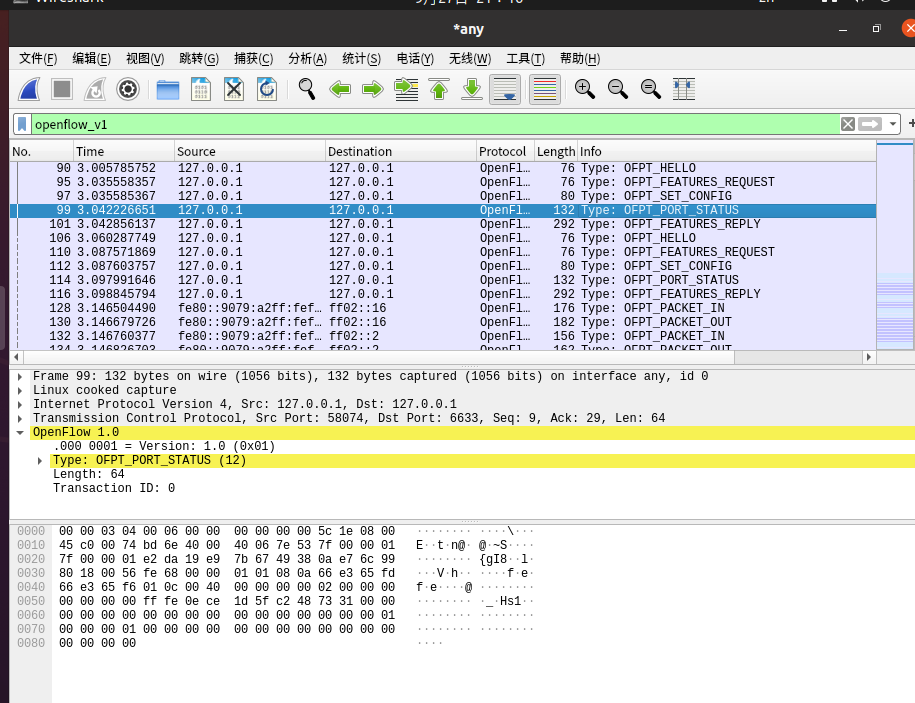
(5)Features_Reply
交换机58076端口(这是我的特征信息,请查收) ---> 控制器6633端口

(6)Packet_in
交换机58074端口(有数据包进来,请指示)--- 控制器6633端口

7)Packet_out
控制器6633端口--->交换机58074端口(请按照我给你的action进行处理)

(8)open_flow_mod
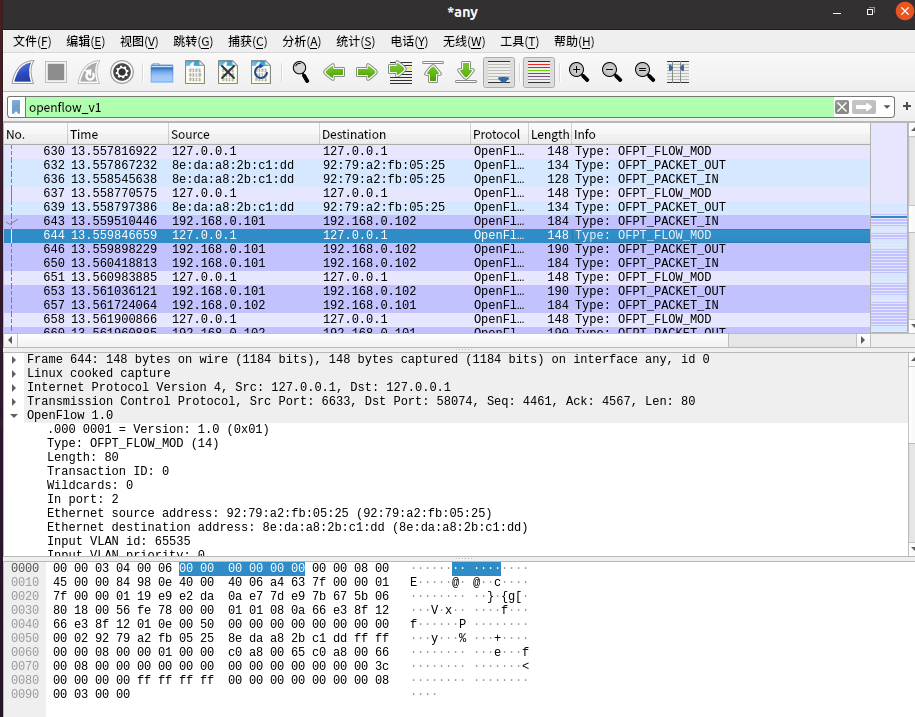
2. 分析OpenFlow协议中交换机与控制器的消息交互过程,画出相关交互图或流程图。

3.回答:交换机与控制器建立通信时是使用TCP协议还是UDP协议?
TCP协议
二)进阶要求
将抓包基础要求第2步的抓包结果对照OpenFlow源码,了解OpenFlow主要消息类型对应的数据结构定义。
/* Header on all OpenFlow packets. */
struct ofp_header {
uint8_t version; /* OFP_VERSION. */
uint8_t type; /* One of the OFPT_ constants. */
uint16_t length; /* Length including this ofp_header. */
uint32_t xid; /* Transaction id associated with this packet.
Replies use the same id as was in the request
to facilitate pairing. */
};
OpenFlow数据包头的通用字段,分别是版本号,消息类型,长度,ID
·HELLO

struct ofp_hello {
struct ofp_header header;
};
HELLO报文用于协商协议,双方发送本方支持的最高版本的协议。最终会使用双方都支持的最低版本协议建立连接。type处会被置为OFPT_HELLO
·FEATURES REQUEST
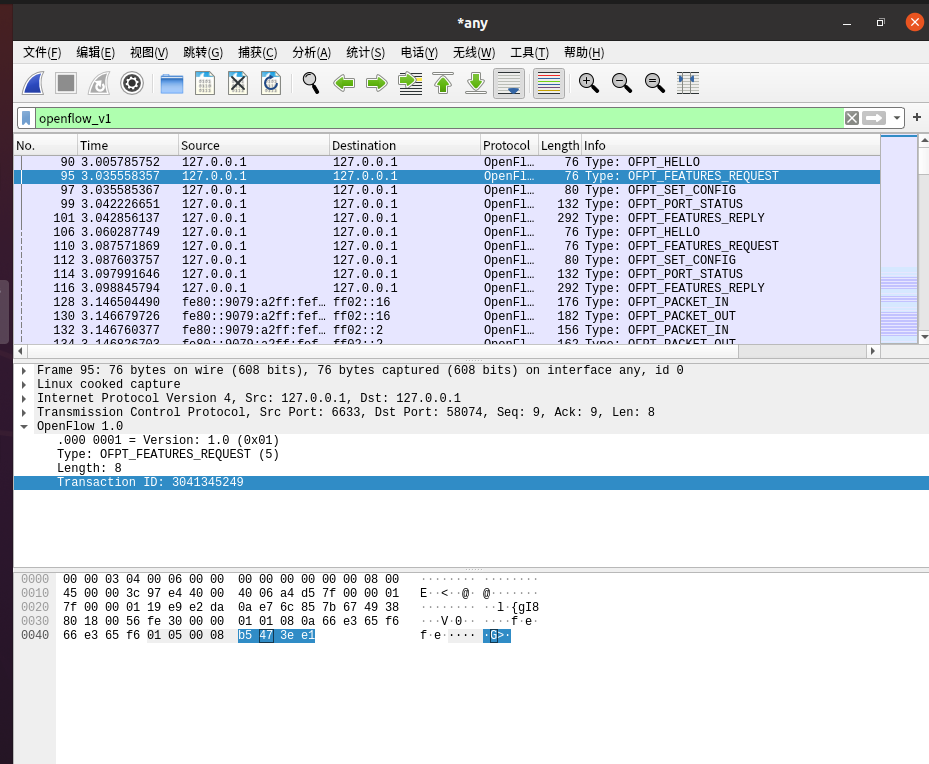
struct ofp_hello {
struct ofp_header header;
};
结构与HELLO一致。
·Set Config
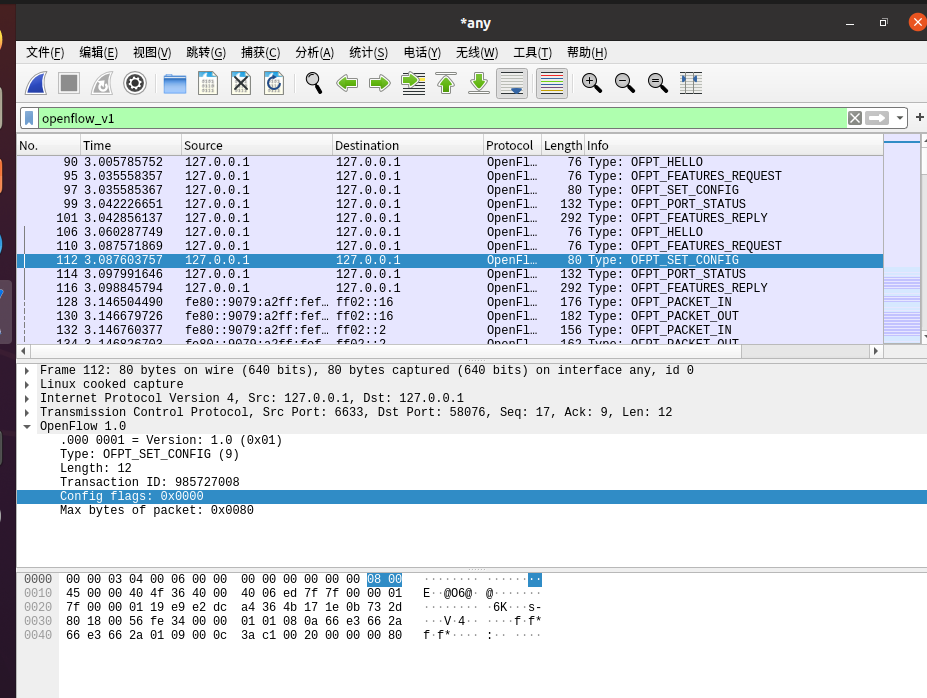
/* Switch configuration. */
struct ofp_switch_config {
struct ofp_header header;
uint16_t flags; /* OFPC_* flags. */
uint16_t miss_send_len; /* Max bytes of new flow that datapath should send to the controller. */
};
·PORT STATUS

/* A physical port has changed in the datapath */
struct ofp_port_status {
struct ofp_header header;
uint8_t reason; /* One of OFPPR_*. */
uint8_t pad[7]; /* Align to 64-bits. */
struct ofp_phy_port desc;
};
当交换机端口发生变化时,告知控制器相应的端口状态。
·FEATURES_REPLY
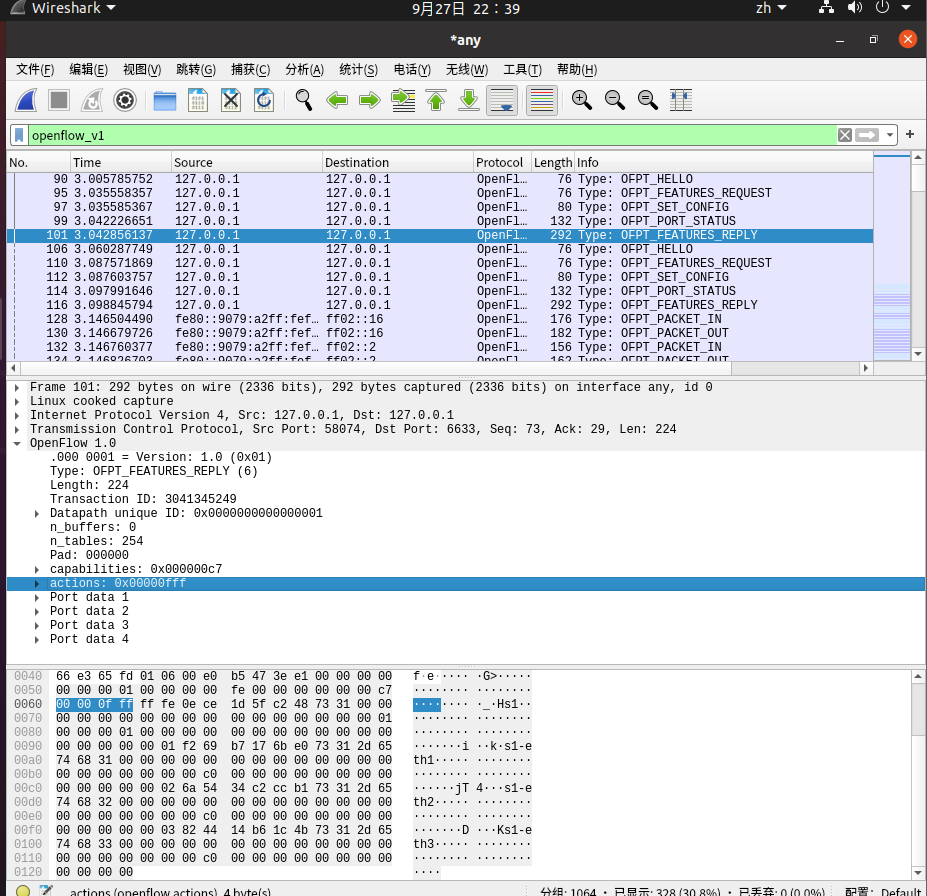
/* Switch features. */
struct ofp_switch_features {
struct ofp_header header;
uint64_t datapath_id; /* Datapath unique ID. The lower 48-bits are for
a MAC address, while the upper 16-bits are
implementer-defined. */
uint32_t n_buffers; /* Max packets buffered at once. */
uint8_t n_tables; /* Number of tables supported by datapath. */
uint8_t pad[3]; /* Align to 64-bits. */
/* Features. */
uint32_t capabilities; /* Bitmap of support "ofp_capabilities". */
uint32_t actions; /* Bitmap of supported "ofp_action_type"s. */
/* Port info.*/
struct ofp_phy_port ports[0]; /* Port definitions. The number of ports
is inferred from the length field in
the header. */
};
·PACKET_IN
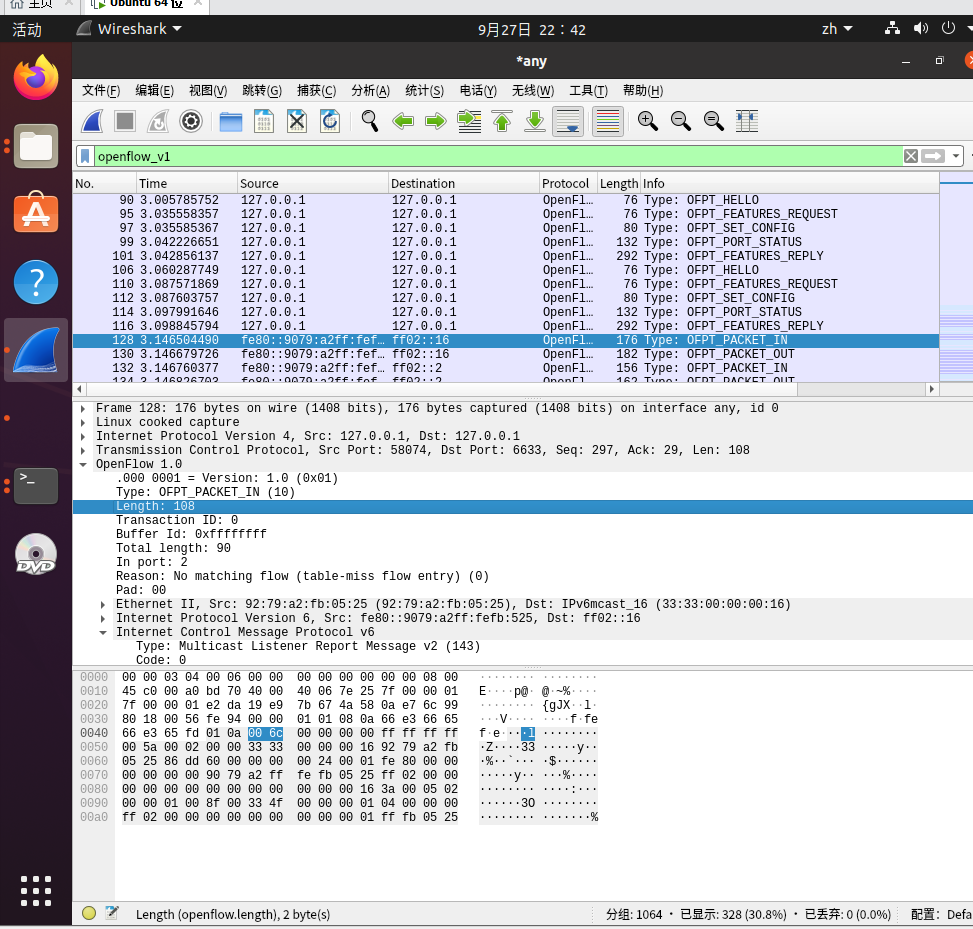
enum ofp_packet_in_reason {
OFPR_NO_MATCH, /* No matching flow. */
OFPR_ACTION /* Action explicitly output to controller. */
};
/* Packet received on port (datapath -> controller). */
struct ofp_packet_in {
struct ofp_header header;
uint32_t buffer_id; /* ID assigned by datapath. */
uint16_t total_len; /* Full length of frame. */
uint16_t in_port; /* Port on which frame was received. */
uint8_t reason; /* Reason packet is being sent (one of OFPR_*) */
uint8_t pad;
uint8_t data[0]; /* Ethernet frame, halfway through 32-bit word,
so the IP header is 32-bit aligned. The
amount of data is inferred from the length
field in the header. Because of padding,
offsetof(struct ofp_packet_in, data) ==
sizeof(struct ofp_packet_in) - 2. */
};
·PACKET_OUT
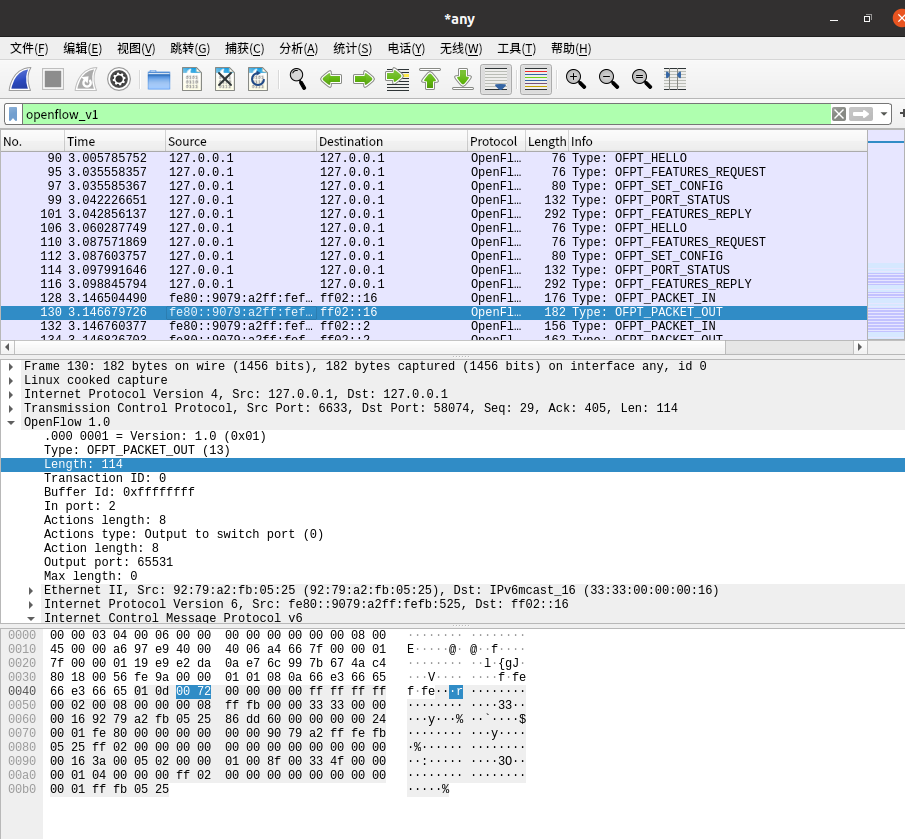
/* Send packet (controller -> datapath). */
struct ofp_packet_out {
struct ofp_header header;
uint32_t buffer_id; /* ID assigned by datapath (-1 if none). */
uint16_t in_port; /* Packet's input port (OFPP_NONE if none). */
uint16_t actions_len; /* Size of action array in bytes. */
struct ofp_action_header actions[0]; /* Actions. */
/* uint8_t data[0]; */ /* Packet data. The length is inferred
from the length field in the header.
(Only meaningful if buffer_id == -1.) */
};
·FLOW_MOD

/* Flow setup and teardown (controller -> datapath). */
struct ofp_flow_mod {
struct ofp_header header;
struct ofp_match match; /* Fields to match */
uint64_t cookie; /* Opaque controller-issued identifier. */
/* Flow actions. */
uint16_t command; /* One of OFPFC_*. */
uint16_t idle_timeout; /* Idle time before discarding (seconds). */
uint16_t hard_timeout; /* Max time before discarding (seconds). */
uint16_t priority; /* Priority level of flow entry. */
uint32_t buffer_id; /* Buffered packet to apply to (or -1).
Not meaningful for OFPFC_DELETE*. */
uint16_t out_port; /* For OFPFC_DELETE* commands, require
matching entries to include this as an
output port. A value of OFPP_NONE
indicates no restriction. */
uint16_t flags; /* One of OFPFF_*. */
struct ofp_action_header actions[0]; /* The action length is inferred
from the length field in the
header. */
};
(三)个人总结
这次实验较前几次实验,难度确实减小了,但是实验报告要求的一些抓包会比较繁琐,从而考验耐心和细心。特别要注意的是要先开启wireshark再建立拓扑,否则会导致部分包抓取不到;除此以外,在建立拓扑结构的时候,记得要把preferences里面的IP Base改成192.168.0.0/24,不然同样也会出错。这次实验遇到的难题大致就上述所说,由于这次遇到的困难并不算很困难,所以在我就没有查阅资料和问同学,在自己的尝试下解决了这些问题。




 浙公网安备 33010602011771号
浙公网安备 33010602011771号